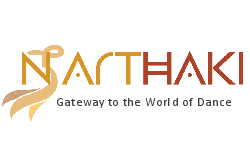
|   |

|   |
Dancers dazzle at Nishagandhi Festival 2025 - Dr. Hareesh N. Nampoothiri e-mail: haree@newnmedia.in Photos: Haree Fotografie March 16, 2025 The Nishagandhi Dance Festival is the flagship dance event hosted by the Dept. of Tourism, Govt. of Kerala. The 2025 edition took place last month, starting on the 18th. The week-long celebration showcased a blend of renowned and emerging dancers, both from the state and beyond, performing a variety of classical dance forms. Impressing the audience 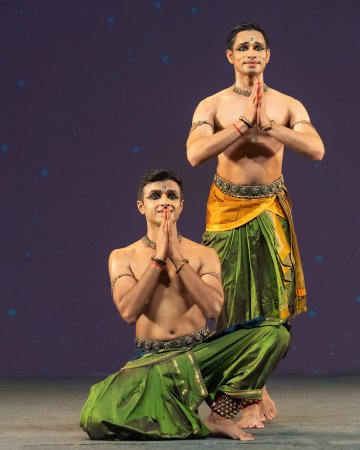 Parshwanath S. Upadhye and Adithya P.V The event opened with a captivating Bharatanatyam duet by Parshwanath S. Upadhye and Adithya P.V. They started with 'Vinayaka Kauthuvam' followed by the varnam "Vanajaksha ninne nammiti...", a composition by T.R. Subramaniam in raga Behag and adi tala. Known for their solo performances, they adeptly adapted these pieces for the duet, crafting choreography that was both dynamic and expressive. The piece celebrated Lord Vishnu's virtues, illustrating various episodes - some briefly, while others were more elaborately portrayed. A standout episode was the depiction of Krishna and Kuchela's friendship. Parshwanath's portrayal of Kuchela added fine moments, such as recalling his starving family while being offered a feast, making the role more engaging. Both dancers made roleplaying seem effortless; however, in this particular episode, Adithya could have emphasized Krishna's realization of Kuchela's deep devotion more strongly. 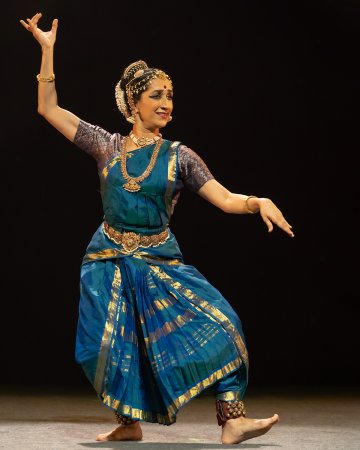 Amrita Lahiri Amrita Lahiri, on the second day, began her Kuchipudi recital with a well-structured 'Shiva Tarangam', choreographed by her guru Jaikishore Mosalikanti. With remarkable flair and intensity, Amrita portrayed the story of Bhageeratha's devotion to Shiva in bringing the river Ganga to Earth. She vividly brought the sequences to life before gracefully executing the dance on the brass plate. Next, Amrita performed the javali "Smarasundaranguni..." in raga Paras by Dharmapuri Subbarayar, enriching the performance with nuanced touches, such as the heroine being presented with a ring in recognition of her mastery over the veena. 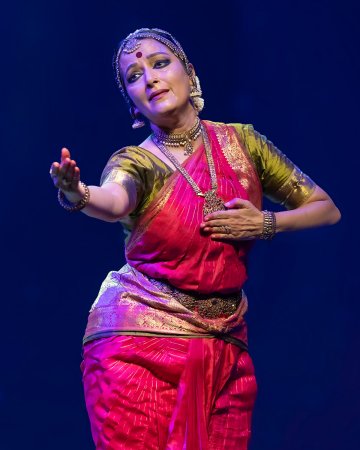 Vidhya Subramanian The two other solo performances during the festival were Bharatanatyam by Vidhya Subramanian and Odissi by Sujata Mohapatra. Vidhya's recital began with 'Sambu Natanam', an ode to the omniscient Shiva inspired by Sage Patanjali's verses. She followed this with the navaragamalika varnam "Samiyai azhaithodi vaa...", a treasured composition by K.N. Dandayudhapani Pillai. While Vidhya's footwork could've been more polished, Vijay Kumar S's energetic and intricate jathis in the nattuvangam stood out. Meanwhile, the recital found balance in Janani Hamsini Narasimhan's soulful and well-modulated singing, which beautifully complemented the dancer. Vidhya excelled in portraying the emotions of a woman immersed in love and devotion. The dancer continued with "Enna thavam seithanai...", a Papanasam Sivan composition in ragam Kapi, and concluded her recital with an enthralling abhang. Her seamless transitions between items, by adding a brief prelude to the varnam and the effortless shift from Shiva's adobe to Krishna's Ambadi, were imaginatively executed and added cohesion to the recital.  Sujata Mohapatra For those who recall Sujata Mohapatra's 2017 performance on this very stage, her latest recital felt like a reprise - albeit with a new music ensemble and costume. She presented the same repertoire, opening with Vishnu Vandana, a mangalacharan set in raga Gurjari Todi. This was followed by a pallavi in raga Hamsadhwani and Ek tali. To conclude, Sujata showcased an excerpt from the epic 'Ramayana', vividly depicting Sita's abduction by Ravana. While her mastery over these pieces was undeniable, and they were presented with finesse, a fresh approach to the recital's structure would have added greater novelty and engagement. 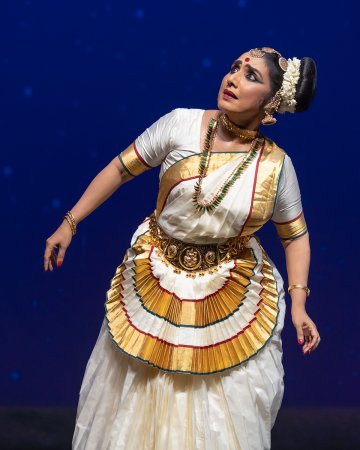 Neena Prasad Yet another solo performer who wowed the audience was Neena Prasad. A recurring performer at the festival, Neena's Mohiniyattam recital on the concluding day was very distinct from her 2017 and 2019 presentations. While the crowning pieces in those stages were centered around mythological narratives, she turned her focus to a pressing contemporary concern - the exploitation of Mother Earth and the urgent need for compassion. In this piece, "Vasundhara sundara dhara..." with lyrics by the late musicologist Pappu Venugopala Rao and music by vocalist Changanassery Madhavan Nampoothiri, Neena masterfully intertwined modern imagery with mythology. Scenes such as a ticking timer leading to an explosion at a rock quarry and a techie engrossed in work on a computer seamlessly merged with the tale of Lord Vishnu's Varaha avatar rescuing Earth. Following this, she performed "Sakhi he kesi...", an ashtapadi from Jayadeva's 'Gita Govinda', beautifully rendered in raga Charukesi. A cholkettu in raga Kedaram at the start and a thillana in raga Kapi to conclude the recital brought in the elegance of her school of Mohiniyattam. Group enchantments During the group presentations at the festival, it was clear that the young disciples who performed alongside their gurus throughout the event were well-trained, showing a flair for dancing, elevating the overall quality of the performances. 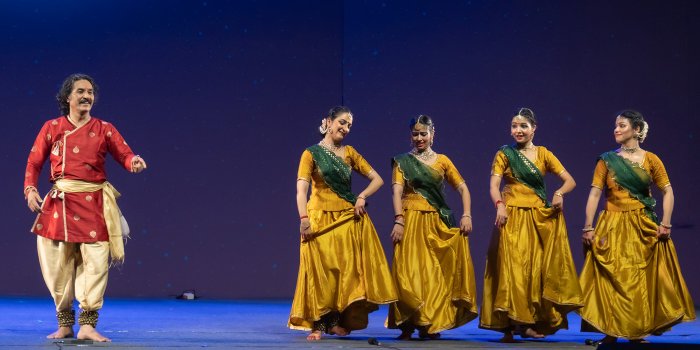 Rajendra Gangani & group On the opening day, Rajendra Gangani and his disciples presented Kathak, starting with a soulful 'Ganesha Vandana'. Rajendra Gangani initially performed Chautaal solo, later joined by his disciples. They then depicted the Ramayana episode of 'Jatayu - the bird', illustrating Jatayu's valiant yet unsuccessful attempt to rescue Sita from Ravana. However, abhinaya did not appear to be the group's strength, making this piece feel somewhat dispensable. 'Dasavatar - a cosmic journey', which followed, was better executed. The team concluded their recital on a high note with 'Taal Tatkal'. Even without live percussion, relying solely on cymbals, they impressed the audience. The energy of the rhythm was infectious, prompting the audience to join in, and the performance reached its peak with a vibrant rendition of Sargam. 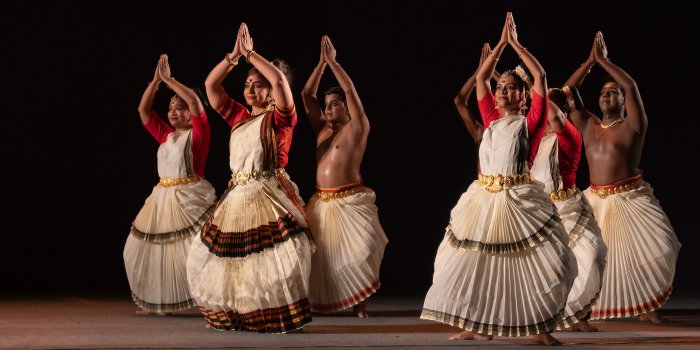 Methil Devika & group Methil Devika, along with her students, had a Mohiniyattam group recital on the following day. The performance began with a cholkettu, a traditional invocation in praise of Shiva and Shakti. Each piece stood out with its distinctive approach, not only in dance but also in its musical arrangements. For instance, in their adaptation of Narayana Guru's Bhadrakali Ashtakam, Methil Devika, alongside Goutham Maheswar, reimagined Kali - not in her usual fierce form but as a more benevolent deity. Following this, she performed the ashtapadi "Priye charusheele..." from Jayadeva's Gita Govindam, joined by Anghitha Pushpajan. By linking the Radha-Krishna context to the poet's own life, Devika brought a unique perspective to the piece. But, having Anghitha sit with her back to the audience did not contribute much to the presentation; the piece could have worked just as effectively as a solo. The team then performed Swarakettu, a composition integrating the fundamental adavus of Mohiniyattam. The recital concluded with "Ennappan Allava...," a song from the Tamil film Nandanar, which carried a distinct folk-inspired essence. The other dancers featured in group items were Ajeissh Menon, Alex Rapheal, Gayathri Devi, and Sobha Madhu. 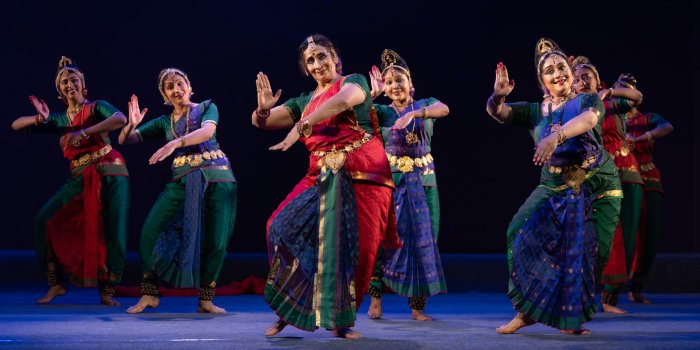 Vyjayanthi Kashi, Prateeksha Kashi & group On the third day, the Shambhavi School of Dance delivered a delightful Kuchipudi group recital featuring Vyjayanthi Kashi, Prateeksha Kashi, and their talented disciples - Diksha Shankar, Ashwini C.K., Neha N.P., Hima Vyshnavi, Harshini Purushothama, Krishna T.P., and Nanda. The performance began with a tribute to Lord Ganesha, showcasing the dancers' skills in "Mahaganapathim...", a composition by Muthuswami Dikshitar in raga Natta. This was followed by "Adivo alladivo...", an Annamacharya composition in raga Madhyamavati and adi tala. While the dancers executed these pieces skillfully, the portrayal of Lord Ganesha with an elephant head and Lord Vishnu with a crown felt unnecessary. Next, Prateeksha and Vyjayanthi Kashi explored the four primary rasas - Sringara, Veera, Bibhatsa, and Raudra - through a piece that incorporated elements from 'Chitra Lohita', previously performed at the Soorya Festival, with a few additional narratives. The recital concluded with a striking performance of "Parama karunalayam...", a tarangam from Narayana Theertha's 'Sree Krishna Leela Tarangini'. The dancers impressed with their intricate floor movements and the traditional balancing act on the brass plate, bringing the performance to a graceful and dynamic finish. 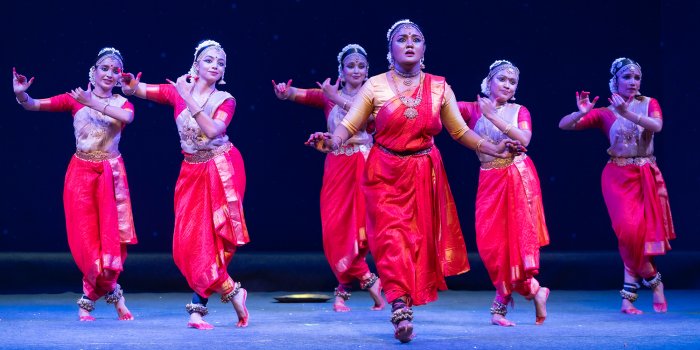 Sreelakshmy Govardhanan & group Kuchipudi group recital by Sreelakshmy Govardhanan and her disciples was on the fifth day of the dance festival. Sreelakshmy's disciples commenced their performance with the acclaimed Kamakshi swarajati, composed by Syama Sastri in the raga Bhairavi and set to the misra chapu tala. Following this, Sreelakshmy Govardhanan joined the ensemble to present a 'Krishna Sthuthi' in the tarangam format. This piece was written by Vasudevan Namboothiri and set to music by Edappally Ajith Kumar. She vividly narrated the story of Poothana attaining salvation, and in the latter part, performed with her team on the brass plate. The finale was "Kanhaiya, yad hai kuch bhi...", a qawwali made famous by Fareed Ayaz. In this expressive piece, Sreelakshmy portrayed a nayika lamenting to Krishna, reminding him of their cherished moments together. Incidentally, this was the only group presentation that featured a live music ensemble, which added richness to the performance. Bijeesh Krishna, the vocalist and recipient of the first Kalamandalam Award for dance musicians, excelled throughout, elevating the recital with his remarkable rendition.  Meera Das & group Odissi group recital by Meera Das and her disciples from Gunjan Dance Academy on the sixth day began with 'Dasavatar', originally choreographed by Guru Kelucharan Mohapatra and adapted for a group by Meera Das. The ensemble - featuring Bhagyashree Aich, Bidya Biswajeeta, Priyanka Jena, Sasmita Panda, and Swapna Dutta - effectively portrayed the ten incarnations without delving too deeply into any one depiction. This was followed by 'Moods of Rhythm', a pure dance piece highlighting intricate tala patterns. The recital concluded with 'Bindu Ru Sindhu', a choreography depicting the journey from a single drop to the vast ocean, brought to life through rhythmic movements and dynamic formations. The pieces were primarily dance-oriented, and Meera Das skillfully united the ensemble, creating a performance that was both fluid and enchanting. On a side note, the contrast in energy and agility between her and her younger students subtly reflected the passage of time in her movements. Youngsters on a roll 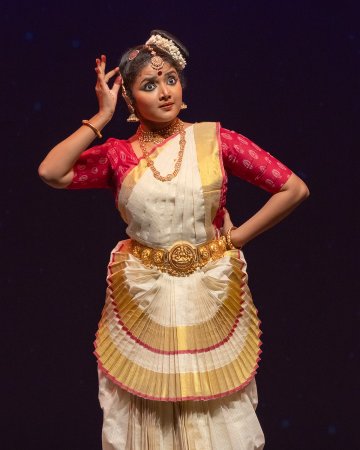 Sandra Pisharody Like the previous years, this year's festival also featured a handful of talented youngsters. On the third day, Sandra Pisharody, a disciple of Guru Nirmala Paniker, began her recital with a graceful rendition of 'Ganapathi Sthuthi' in raga Hamsadhwani and adi tala. Her depiction of Bala Ganapathy, tenderly cared for by his mother, added an endearing touch. The highlight of her performance was the centerpiece, 'Kundalini Pattu,' penned by Narayana Guru which was rendered in ragamalika and talamalika. Supported by meticulously tuned music featuring the Kurumkuzhal, the song of the Kundalini serpent depicted various aspects of Shiva. Sandra shone in the sancharis, particularly in the depiction of Kamadeva's incineration, and in the dance sequences, where her measured restraint stood out. 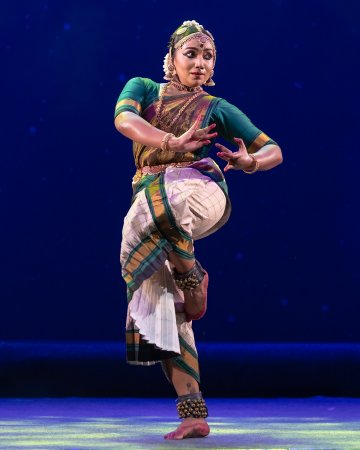 Amritha Jayakrishnan Amritha Jayakrishnan, a disciple of Vidhya Subramanian, showcased her Bharatanatyam on the fifth day. With poise and precision, she began by celebrating union - depicting the harmony between earth and rain through Muthuswami Dikshitar's "Anandamrithakarshini..." in raga Amritavarshini. She looked elegant and well-composed, both in her movements and in the moments of stillness in between. Transitioning to 'Ardhanarishwara Stotram,' set to music by Bhagyalakshmi Guruvayur in ragas Purvikalyani and Behag, she effectively conveyed the contrasting emotions, highlighting the balance of masculine and feminine energies of Shiva and Shakti. In the timeless Swathi Thirunal padam "Aliveni enthu cheyvu..." in raga Kurinji, she captured the essence of the longing heroine through her own choreography. Amritha concluded her performance with Rajarajeshwari Ashtakam, set to music by Rajkumar Bharathi. 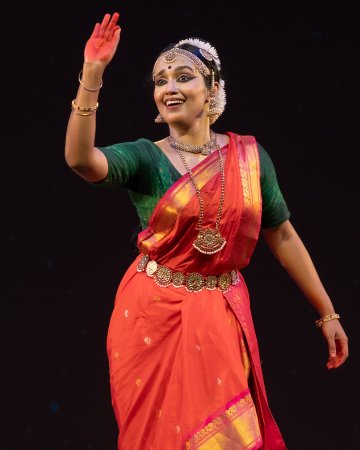 Aishwarya Meenakshi The following day, Aishwarya Meenakshi, a disciple of Sreelakshmy Govardhanan, began her recital with 'Dasavatara Sabdam', captivating the audience with her lively stage presence. She then followed it with 'Shurpanakha,' a poignant piece choreographed by her guru. This composition reimagines Shurpanakha as a woman who has endured deep trauma. Aishwarya portrayed the character's emotional turmoil with great sensitivity, unraveling the intricate layers of the narrative. The inclusion of live vachika and the mizhavu in the background score brought depth and richness to the recital, enhancing its overall impact. 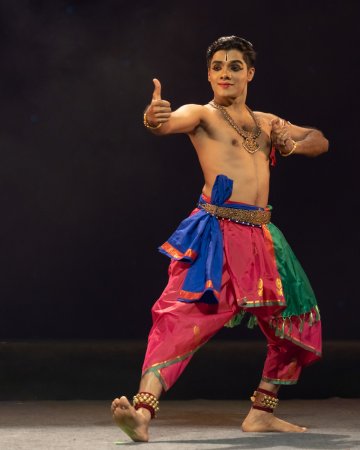 Arjun Subramanian Bharatanatyam solo recital by Arjun Subramanian on the concluding day commenced with the 'Sree Poornathrayeesa Stuti' set in the raga Anandabhairavi. The dance portions were well-paced, and Arjun presented them with finesse. Without pausing, he proceeded to the main piece - the celebrated Swathi Thirunal varnam "Sumasayaka..." in the raga Karnataka Kapi, set to rupaka tala. While he conveyed the emotions of the pining heroine with sincerity, a more nuanced approach could have made the character's yearning more palpable to the audience. The Department of Tourism certainly deserves credit for organizing the event commendably. Every aspect, from stage design and event branding to lighting, sound, and compering, was meticulously planned and executed. The performances were held at the Nishagandhi Auditorium, situated within the Kanakakkunnu Palace grounds in Thiruvananthapuram, the capital city. 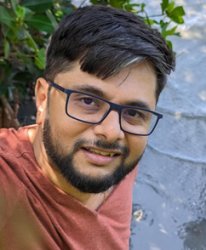 Dr. Hareesh N. Nampoothiri is a design and media consultant, author, photographer, director, and art enthusiast with a PhD in Computer Science. He founded NEWNMEDIA and Haree Fotografie, focusing on dance productions and photography, and also launched Artograph, a bi-monthly e-magazine dedicated to classical arts. He regularly writes about performing arts, has done several video productions, and has held photo exhibitions. |